Quadrata Tutorial
Daily puzzles free to download and print out or buy books of 250 graded puzzles from Amazon.
|
Additionally, Quadrata puzzles can use letters instead of numbers and instead of resorting to 'ABCDEF...', the Quadrata puzzle randomises the order so you might get 'BFDGCE' - I have left out the vowels because without them there are so few words in English and 'W' only makes an appearance in puzzles of 18x18 or more. In that way, one of the problems of randomly selected letters is avoided completely - that is to say profanity. The Quadrata is a Latin Square - a character can appear no more than once in any row or column. Additionally, clues are given as to the relative value of some adjacent pairs by indicating with an inequality - > (greater than) and < (less than). These can be horizontal or vertical as you can see from the image on the right. You can see from the animation that the process of solving it is one of a set of steps that gradually fill in the puzzle until it is complete. Each step uses the clues that are provided with the puzzle at the beginning or information that you have derived from that. The variant with words instead of random letters is solved in the same way so here, you can find out how to solve them all. To restart the animation, just click the image.
With the idea that ink can only be added, a way of marking the cells so that as a value option disappears,
the cell is marked so that in the end, only one value can be used for that cell. Personally, I just mark the
cell with a dot whose position within the cell defines which character it represents. In the Sudoku and Kakuro
puzzles, the maximum value is always 9 so a 3x3 array is used but here, puzzle sizes can theoretically go from
2x2 to anything although, as you will gather from the trivia page,
there are practical limitations: with numbers, it is 0..9; words, there is a limit on the number and length of
words where only five vowels are used there are very few word combinations at 19x19; and, with letters, it is
in effect 26 but before you get near to that, computing time provides an effective barrier as the puzzle
building is 'np complete'.
For the sake of clarity, the new dots are in red and dots from previous stages are turned blue.
Where there is an inequality, the greater-than cell cannot offer a home for an lower-limit number that is less than the lower-limit on the other cell so if the 1 and 2 has a dot in the less-than cell, the greater-than cell needs to have marks in the 1, 2 and 3 positions. The same applies for the upper limits for cell values. If you look at the start of the second row down, the first cell is greater than the second cell so it cannot have a 1 in it. Likewise, the second cell cannot have a 6 in it so that position has a dot in it. Looking at the bottom-right corner, starting with the 2, the cell on its the right is greater than 2 so the 1 has had a dot added to it. The cell below that has 1, 2, 3 blocked and to its left, the 1, 2, 3, 4 are blocked. Working from the end of that chain, going the other way, the last cell in the chain already has a 6 blocked
because there is a 6 in that row. The bottom-right cell cannot have a number higher than 4 in it so the 5 is
blocked. Above that, the next cell in the chain cannot have a 4, 5, 6 in it so those are dotted.
Further to that, once the six is in there, only one in that column has not got a value written in it so that
must be a 1.
* First, Click Here. An important feature of the fourth column is that the second and last cells in it are identical insofar as both of them only have room for two values - 2 and 3. In instances like this - where you have a row or a column with two cells that can have only the same two values - those values can be eliminated from the other cells in that row or column, ie, if it is a column as it is here, then the other cells in that column should have those two values eliminated. In that way, the top cell can only have a 4 in it. Then, Click Here. In puzzles that are larger, there are likely to be cells in a row that you can eliminate pairs of numbers from like this and they don't always have other ways of doing it. Note that this also works with three cells with the same three values and so on. Solving Words and Letters Quadrata
If you can transpose the spots into the letters in the order easily enough, then you can do that and the process will be the same as for the number puzzles. However, for the rest of is, the first step is to number the letters at the bottom and then, write them on teh letter squares. Following that, the rest of the process is the same except that when you arrive at an answer for a cell, I would suggest that you
write the number on the cell - I use the top left corner - and then write the letter in it.
Click on the image to restart it. |
Copyright ©2019-2023 Paul Alan Grosse.
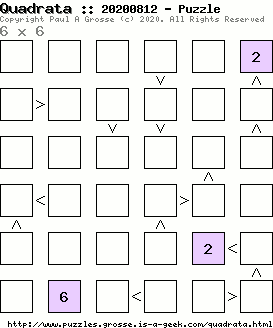 This is the basic Quadrata puzzle that you are presented with each day. The smallest number version that you will
see is the same as the Futoshiki puzzle that you will see in your local newspaper each day except that as the week
goes on, it gets larger, until on a Sunday, it measures 10x10 cells.
This is the basic Quadrata puzzle that you are presented with each day. The smallest number version that you will
see is the same as the Futoshiki puzzle that you will see in your local newspaper each day except that as the week
goes on, it gets larger, until on a Sunday, it measures 10x10 cells.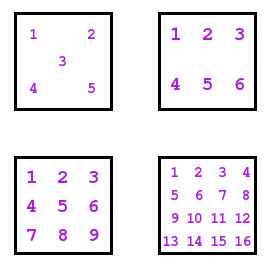 As the Latin square is designed so that each column or row can have no more than one instance of
a particular value, it makes sense that we should have some means of marking each cell so as to indicate which
values cannot go in there.
As the Latin square is designed so that each column or row can have no more than one instance of
a particular value, it makes sense that we should have some means of marking each cell so as to indicate which
values cannot go in there.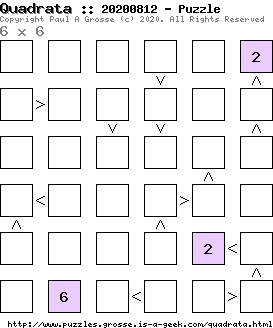 So, we have our puzzle. This one has inequalities and clue characters - the smaller puzzles can be formed with
just characters or just inequalities.
So, we have our puzzle. This one has inequalities and clue characters - the smaller puzzles can be formed with
just characters or just inequalities.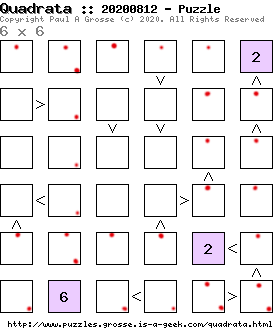 Rows and Columns - The first step is to examine the puzzle for obvious cells to fill and there is one
series in the bottom right. However, it is rare that you will find these so we will go with the normal first
step which is to mark the rows and columns with the character values that are already there.
Rows and Columns - The first step is to examine the puzzle for obvious cells to fill and there is one
series in the bottom right. However, it is rare that you will find these so we will go with the normal first
step which is to mark the rows and columns with the character values that are already there.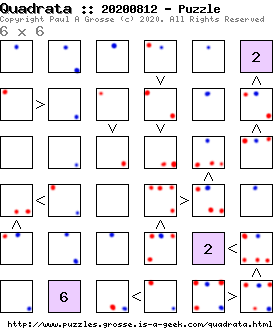 Enforce Inequalities - The next step is to apply the conditions of any inequalities to the cells that they
apply to. These are marked on the puzzle as red dots in this step.
Enforce Inequalities - The next step is to apply the conditions of any inequalities to the cells that they
apply to. These are marked on the puzzle as red dots in this step.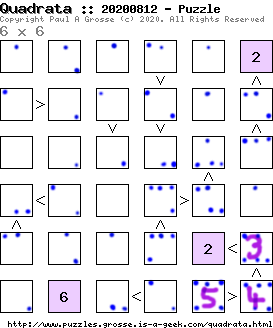 Dot-Constrained Characters - Next, we write in any characters where the dots leave only one value. In the
series at the bottom-right, there is only one space left of dots in each cell so there is only one number that
can go there.
Dot-Constrained Characters - Next, we write in any characters where the dots leave only one value. In the
series at the bottom-right, there is only one space left of dots in each cell so there is only one number that
can go there.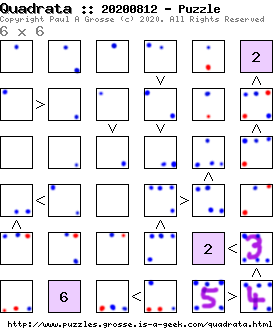 From the new numbers, we can go through the Columns and Rows again.
From the new numbers, we can go through the Columns and Rows again.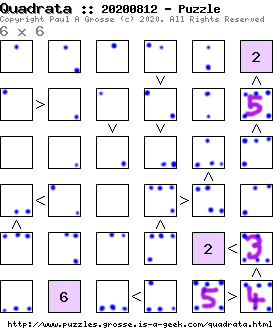 Then, we find that we can insert a five on the right-hand side because it is Dot Constrained.
Then, we find that we can insert a five on the right-hand side because it is Dot Constrained.
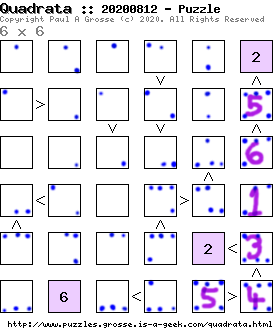 Constrained Values - Now, without adding any more dots - they are, after all just a guide and not the
aim of the puzzle - we can see that the only number bigger than five on the right-hand side is six.
Constrained Values - Now, without adding any more dots - they are, after all just a guide and not the
aim of the puzzle - we can see that the only number bigger than five on the right-hand side is six.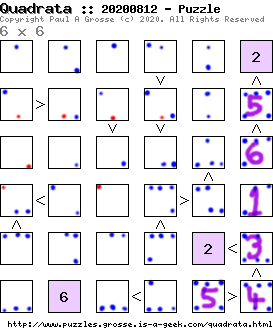
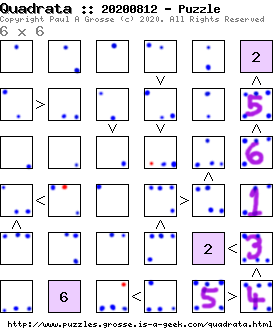
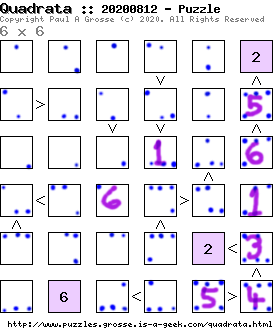
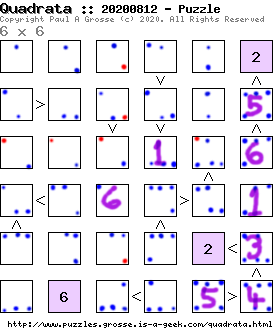
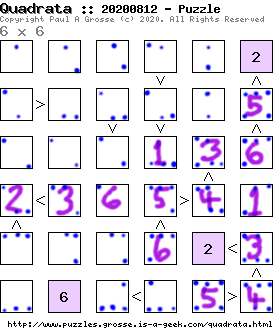
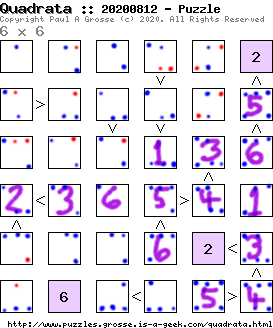
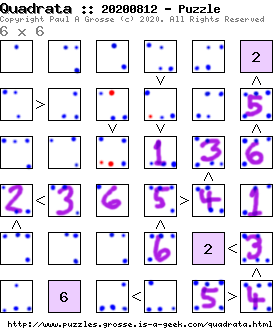
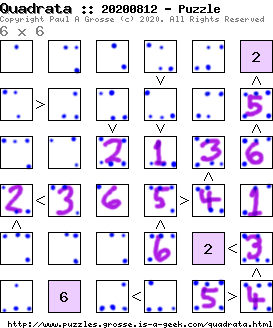
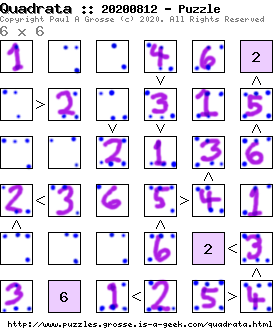
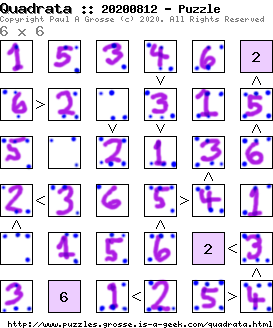

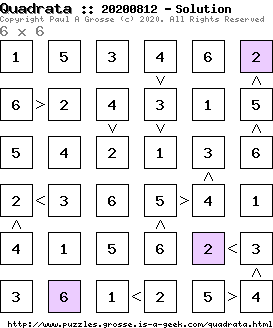
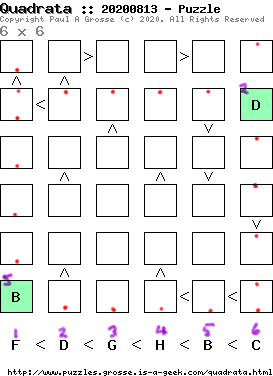 Solving the word- and letter-Quadrata puzzles is pretty much the same as the number puzzles. However, the order of the characters
is given at the bottom of the puzzle. The word puzzles should be a bit easier because the order is in the form of words that you
are either familiar with or can fairly quickly become familiar with.
Solving the word- and letter-Quadrata puzzles is pretty much the same as the number puzzles. However, the order of the characters
is given at the bottom of the puzzle. The word puzzles should be a bit easier because the order is in the form of words that you
are either familiar with or can fairly quickly become familiar with.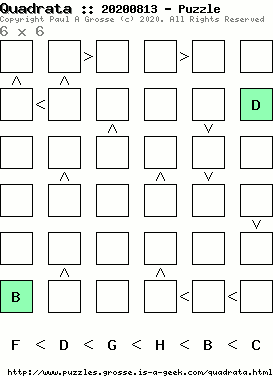 This is the process of solving the letter puzzle.
This is the process of solving the letter puzzle.